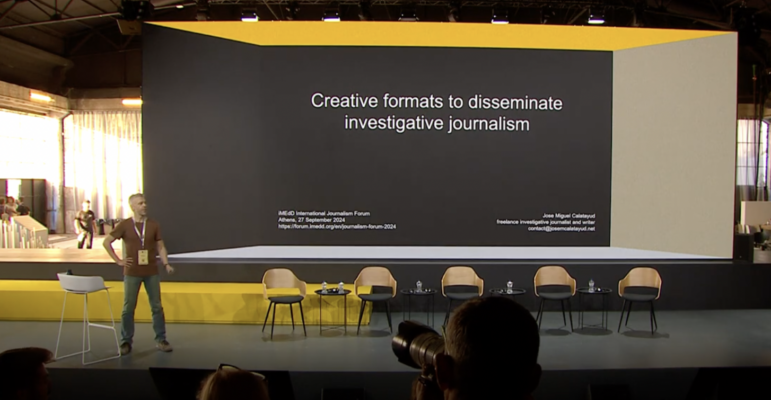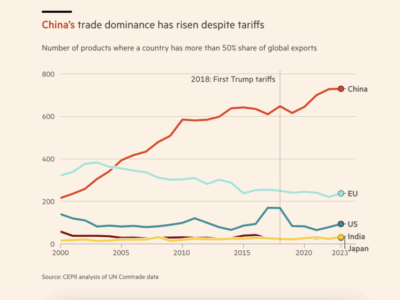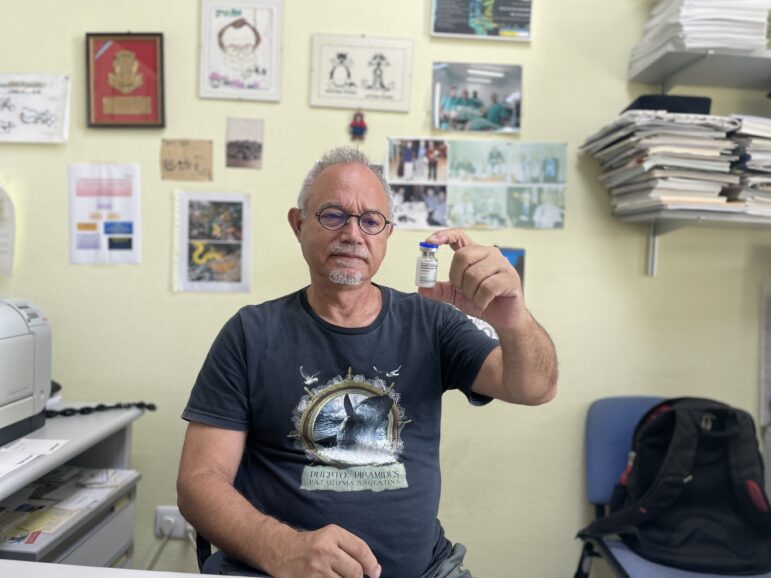
“Some of you may disagree with this. But we live in a golden era of investigative journalism…”
“At least when it comes to quantity,” added freelance journalist Jose Miguel Calatayud. “There are many, many investigations being published in Europe, globally, and cross-border. In just a few years it’s become a mature field… and I think we can argue that they’re having impact.”
Calatayud, a Spanish journalist based in Berlin, delivered a presentation on creative formats for disseminating investigative stories at the 2024 iMedD International Journalism Forum in Athens, Greece. “What I understand as a creative format, as a very simple non-scientific definition, is publishing journalistic content in formats that are not very common and go beyond the conventional text, audio, image, video,” said Calatayud.
His goal was to share his insights from researching the topic, to explore the advantages and disadvantages of different publishing methods, and to get journalists, editors, managers, and funders to be open to creative format ideas.
News Avoidance vs. Curiosity
In the session, Calatayud also addressed news and information avoidance and how creativity can help investigative journalists overcome it.
When it comes to big investigations particularly, he explained, the general public is often not even aware they exist. And when they do break through, audiences rarely make the effort to go through all of it, because often these are detailed reports with a lot of text, and sometimes also include video, audio, and infographics.
“Which makes me think sometimes… We come to these conferences, we talk among ourselves and, I have the impression — and several colleagues of mine have told me the same — that the main audience for investigative journalism is other investigative journalists,” said Calatayud. “And that’s not cool, because we really need to reach the wider public.”
From his research into news avoidance, he noted that studies have been showing for years that we avoid or disregard information for many reasons: that we don’t agree with it; that it takes too much time or too much effort to consume; and that it could make us feel uncomfortable.
“We are also very good at avoiding or disregarding information that could make us feel powerless or, on the other hand, that makes us feel that we should act, and can act, [when] we don’t want to, because we feel it’s… not our responsibility,” said Calatayud.
“Investigative journalism tends to check all those boxes,” he pointed out. It’s news and information that makes people uncomfortable, that is about complicated things that often make us feel responsible, or that there’s a need to act,” he added. As a result, people often avoid reading or consuming big investigations.
But there is something investigative reporting can capitalize on, Calatayud said. He cited a 2017 Financial Times article about a research paper showing that people who ranked high in curiosity as a trait were much more open to new information, to considering it critically, to changing their views based on new information, and to discussing things with people who had different opinions.
“I like this quote from the article: ‘Curiosity brought people together in a way that mere facts did not,’” said Calatayud. We should consider using creative formats to reach wider and more diverse audiences, to make them curious, and to make them interested and engaged with the subject matter, Catalyaud added.
Different Kinds of Creative Formats
Calatayud has experimented with unconventional dissemination methods for his own beat — undue corporate influence on public life — producing a “satirical how-to” guide to corporate influence in Europe. “It talks to an imaginary audience, someone working in the corporate world who wants… to maximize profits even if their product is toxic. Because this happens in real life. This guide tells you how to do that,” explained Calatayud, with examples from real-life companies and real-life investigations.
From his extensive research into creative investigative journalism publishing and distribution formats, he came up with the following alternatives:
- “Spicing up” conventional storytelling — creative or humorous elements in an article or broadcast, such as Calatayud’s satirical guide
- Comics and other illustrated narrative formats.
- Animated films — not the small clips often used as explainers to accompany an article, but features of 30 minutes or more.
- Theater and other stage shows, including music.
- Virtual reality (VR) and augmented reality (AR).
- Online games, card, and board games.
- Posters — physical and digital, static and animated.
- City and field tours.
- Workshops and other practical activities.
- Other types of interventions or “happenings” in public spaces.
But do creative formats work? And is the extra investment in time, work, and money really worth it? As he compiled examples for his research, Calatayud reached out to journalists and editors who worked on it to ask these questions. He shared some of these lessons learned for each broader category with iMedD Forum attendees.
-
In-Person, Live-Format Events
Tours, workshops, theater, stand-up comedy, concerts, and other planned events can be an enriching experience for both the public and journalists. Conventional reporting is an individual experience, Catalyaud observed, but allowing people to add their voices to the story engages them. On the other hand, these kinds of events tend to reach only local audiences and are therefore not the best method for expanding to new ones. Live events can also be time-consuming, labor-intensive, and potentially expensive. (Read GIJN’s coverage of Austrian member Dossier — which has been producing plays for theaters in Vienna based on their investigations — for more on the advantages, costs, and challenges of producing investigative theater.)
-
Digital, Asynchronous (Not Immediate) Formats
These include unusual storytelling, interaction, online games, and VR and AR immersion. Interactive elements can be measured in ways that other formats cannot, and can greatly increase the time an audience spends with the content. Catalyud cited an example where audiences spent a minute-and-a-half on an article, but 20 minutes when they featured an online game. He also mentioned The Uber Game — in which readers play a ride-hailing driver in London trying to make ends meet — which accompanied a big 2022 Financial Times investigation into how hard it is to make a living driving in London. “They thought that the game was the best way, because of the storytelling value and [because games] can be good for generating curiosity and empathy, allowing people to step into other people’s shoes,” said Calatayud.
VR in particular can help reach new audiences, he explained, citing the VR documentary, “Home After War” about Fallujah in Iraq: “Once it was available on the on the online [app] store, they saw that it had half-a-million downloads, which was a lot, even though they don’t know who exactly downloaded it… the big majority of the users there are teenagers who use those headsets to play games, so they are assuming that they reached a few hundred thousand teenagers, which with this kind of war reporting [one] otherwise couldn’t.” Another advantage is that online games have a long shelf life — people still engage with them long after their original publication. But again, these projects can be time-consuming and very expensive, especially VR.
-
Non-Digital Asynchronous Formats
These include creative printed storytelling (such as comics and graphic novels) and card and board games. Investigative journalist Greg Palast created a satirical “Joker’s Wild” playing card deck, featuring in place of kings and queens a cast of characters in President George W. Bush’s orbit, drawn from Palast’s investigations into the 2000 US presidential election.
Other examples Calatayud has seen include a Watergate board game produced by Capstone Games; Doubt Is Our Product, which explores the tobacco disinformation and lobbying industry in the 20th century; and Formateurs, a card game made by Belgian investigative newsroom Apache in which players can try to form governments with political coalitions. He explained that while he has heard anecdotally that these kinds of games can bring new audiences, the impact is hard to assess because there is usually no way for people to give feedback on engagement. Again, these products may be time-consuming and expensive to produce.
Commonalities
From his research and feedback from journalist colleagues, Calatayud noted that while there are many options for creative storytelling and ways to measure impact, he has observed some common threads. He warned that each format has different ways of defining and measuring reach and impact, so it can be difficult to compare between formats and across publishers. Also, for the most part, these alternative publishing projects are time-consuming and expensive and are often hard to plan in advance if you’re aiming for a newsworthiness hook. In short, creative distribution projects take “extra time, extra work, extra money.”
“Several colleagues told me that when they were pitching these kinds of formats, they were facing resistance from senior staff,” acknowledged Catalayad, who suggested it might be a generational difference in approach. He also noted that, often, from the perspective of non-editorial staff, creative formats were often seen as one-off experiments — a good learning experience, but there was no long-term planning to keep doing them.
To conclude, Calatayud shared some key takeaways:
- Information and news avoidance is a reality.
- Creative formats are just one way to combat it.
- Investigative journalists must experiment in strategic ways to help unlock curiosity and reach wider audiences.
- For journalists: Pitch creative formats for your stories. “[Just pitching them] is very low-cost for you.”
- For editors: Be open to creative pitches. “Sometimes they are the best storytelling device you have, and if not, they can still add narrative value.”
- For non-managers: “Think of them as experiments, but inside a longer-term strategy.”
- Finally, for funders: “Please give us money to experiment with them in strategic ways.”















